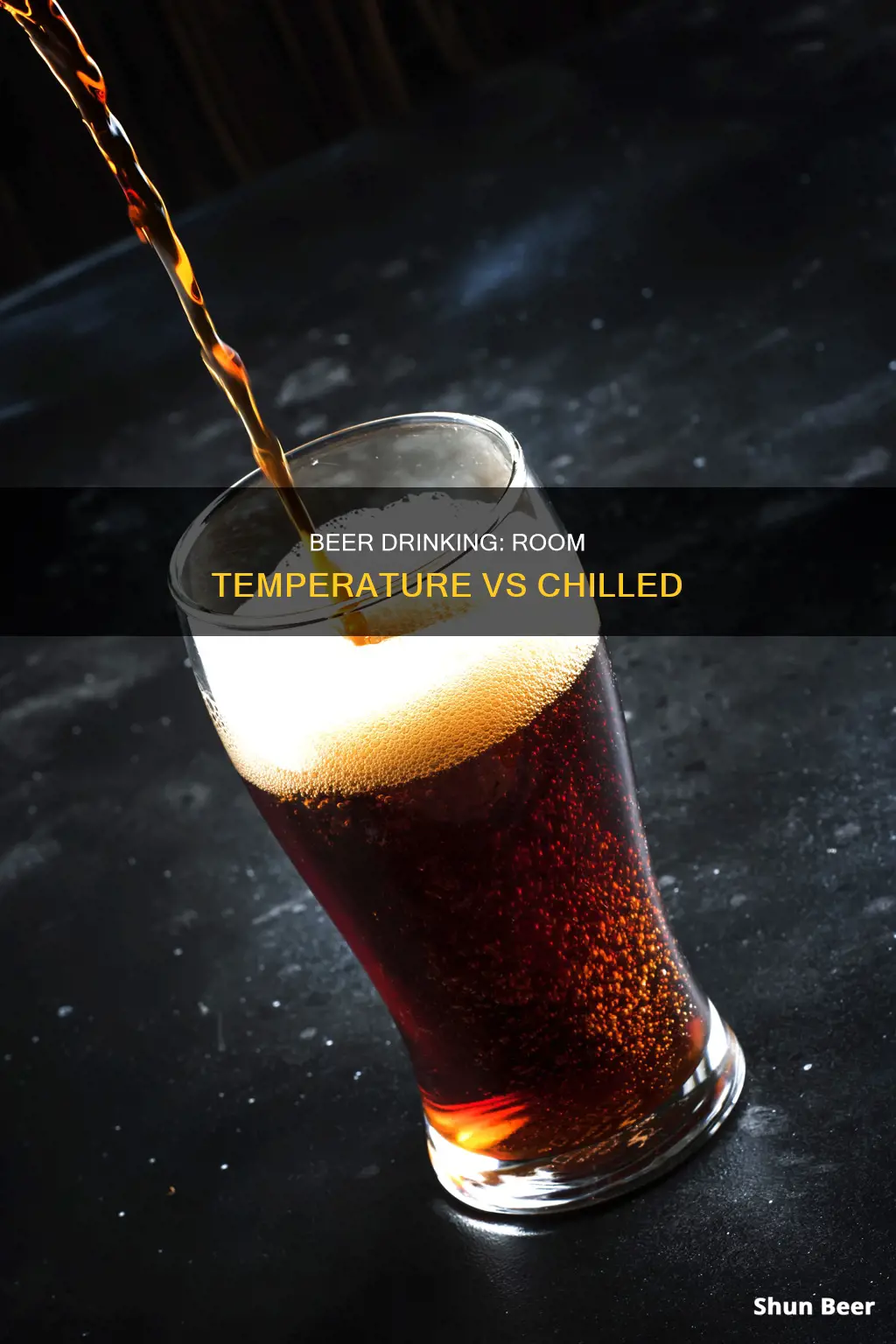
Drinking beer at room temperature is a topic of debate, with some people preferring their beer chilled and others opting for a warmer drink. While it's generally accepted that beer is best served cold, there are certain types of beer that are traditionally served at room temperature or warmer, and this practice has historical and cultural roots.
What You'll Learn

It is safe to drink beer at room temperature
The preference for drinking cold beer is a recent development. In the 20th century, beer fell out of fashion at room temperature due to storage concerns. Beers stored at warm temperatures for extended periods can spoil, and mass-produced beers required cold temperatures for safe shipping and storage.
However, drinking beer at room temperature can enhance its flavour. Warmer temperatures can bring out more subtle notes in the beer, making it easier to detect fruity or spicy notes that may be lost when it is cold. This is particularly true for darker beers like stouts or porters, which can develop deeper notes when warmed up slightly.
It is important to note that beer should not be warmed above room temperature, as this can cause potentially damaging chemical reactions between the alcohol and other constituents in the drink. Additionally, drinking warm beer has some drawbacks, such as being less refreshing and potential health risks if the beer is stored improperly.
Ultimately, the ideal temperature for drinking beer depends on personal preference and the style of beer being consumed.
Beer and Advil: A Safe Mix?
You may want to see also

Warmer beers have a more pronounced aroma
When beer is served too cold, the temperature slows the volatilization of aromatic compounds, causing them to linger in the beer. This dramatically changes the apparent flavour and aroma of the beer, sometimes to the point where it may come across as thin and tasteless.
Warming beer allows more of its flavours and aromas to come to the forefront. However, as beer approaches room temperature, the sensations from hop bitterness and carbonation can decrease, which can lead to an almost flat-tasting experience.
The ideal temperature for serving beer is between 38-55° F. Warmer beers (60°F) include barleywines, imperial stouts, and doppelbocks. These sweeter beers will allow you to let the sweet malty aroma bloom over the bitter base notes.
English ales, Belgian ales, stouts, porters, and barleywines are also best served warm to fully appreciate their flavours. The roasted notes and chocolate flavours in stouts and porters, for example, come out more at warmer temperatures.
While modern beer culture in America centres around the image of an ice-cold can of light lager on a hot summer day, craft beer enthusiasts and homebrewers are embracing a wider variety of contemporary and historical recipes, many of which are served very differently from traditional mass-market offerings.
Ginger Beer: A Standalone Beverage?
You may want to see also

Beer tastes different at different temperatures
The type of beer also plays a role in determining the optimal serving temperature. Generally, light-bodied, low-alcohol beers are best consumed cold, while heavier, darker drinks will taste more full and well-balanced at warmer temperatures. For example, full-bodied ales are best enjoyed at nearly room temperature. Sweet beers like barley wines, imperial stouts, and doppelbocks are better when served warmer (around 60°F). Stouts, porters, and higher-gravity brews will be more flavourful at the 50-60°F range.
It is worth noting that the difference in taste at different temperatures is not due to chemical changes in the beer. Experiments have shown that warming and then rechilling beer does not affect its quality. However, beer left in a warm place for an extended period may spoil due to oxidation, UV exposure, or bacterial growth.
Beer and Pap Smears: What You Need to Know
You may want to see also

Beer was historically consumed warm
The belief in the health benefits of warm beer was based on a popular, if inaccurate, notion of human physiology. Drinking cold beer was thought to upset the balance of the stomach, which was believed to be ruled by two "master-qualities": heat and dryness. It was also thought that drinking cold beer could upset digestion and vapourous humours.
In the days before mechanised refrigeration, beer was commonly served at cellar temperatures. During the summer, both cellar and serving temperatures crept upwards, but tavern keepers never gave it a second thought. In the winter, warm beer was equally expected and welcomed. The interior heating of those days may have been woefully inadequate, but a hot tankard provided a pleasant and comforting distraction. It added variety to what was, at times, a difficult and mundane lifestyle.
The preference for cold beer is actually quite a recent development. In the 20th century, the introduction of lager beer and the advent of artificial refrigeration changed drinking habits. Lager beer was brewed to be drunk cold, and refrigeration made its production possible anywhere and year-round. Americans responded by enthusiastically embracing light, crisp, ice-cold lagers. In the process, heated ales became "old-fashioned" and quickly disappeared.
Drinking Beer and Taking Nitrofurantoin: What You Should Know
You may want to see also

Some beers are better suited to being drunk warm
Drinking beer at room temperature may be seen as unusual, but it is not a new phenomenon. In fact, throughout history, beer was often consumed warm, and in some cases, hot. From the 1600s to the 1800s, it was common to be served warmed ale during the winter months. These drinks were often spiced and sweetened, and people believed they had health benefits.
Today, some beers are better suited to being drunk at warmer temperatures. The serving temperature of a beer depends on its style. Imperial stouts, for example, are generally best served around 55°F (12°C), while a Belgian Tripel, a high-ABV style, should be served around 45°F (7°C). Beers that tend to be served warmer usually have a higher alcohol content. Cask ales or real ales from England, such as English Bitters and Old Ales, are meant to be served at cellar temperature (50-55°F or 10-13°C).
Full-bodied ales are often best enjoyed at nearly room temperature. Sweeter beers like barley wines, imperial stouts, and doppelbocks will be better when served at a warmer temperature (up to 60°F or 16°C). This is because higher temperatures make many chemical compounds more volatile, and volatile compounds are more easily perceived as aromas and flavors. Warmer temperatures allow the sweet malty aroma of these beers to bloom over the bitter base notes.
On the other hand, hoppy, bitter beers are better at colder temperatures. If you want to highlight the hoppy bitterness of an IPA or the carbonation from an American lager, it’s best to serve them chilled. Generally, light-bodied, low-alcohol beers are best consumed cold, while heavier, darker drinks will taste more full and well-balanced at warmer temperatures.
Insulin and Beer: Is It Safe to Drink?
You may want to see also
Frequently asked questions
Yes, it is safe to drink beer at room temperature. Any safety concerns come down to production and storage conditions, not serving temperature.
No, studies have shown no difference in individuals' blood-alcohol levels after consuming alcoholic beverages at different temperatures. However, the placebo effect of expecting a higher alcohol content can actually make you feel drunker.
An unopened bottle of beer can last between 6-9 months at room temperature. The fridge will extend the shelf life to about two years.
Beers that are generally consumed at room temperature include brown ales, porters, stouts, old ales, barleywines, imperial stouts, doppelbocks, English ales, Belgian ales, and winter warmers.







